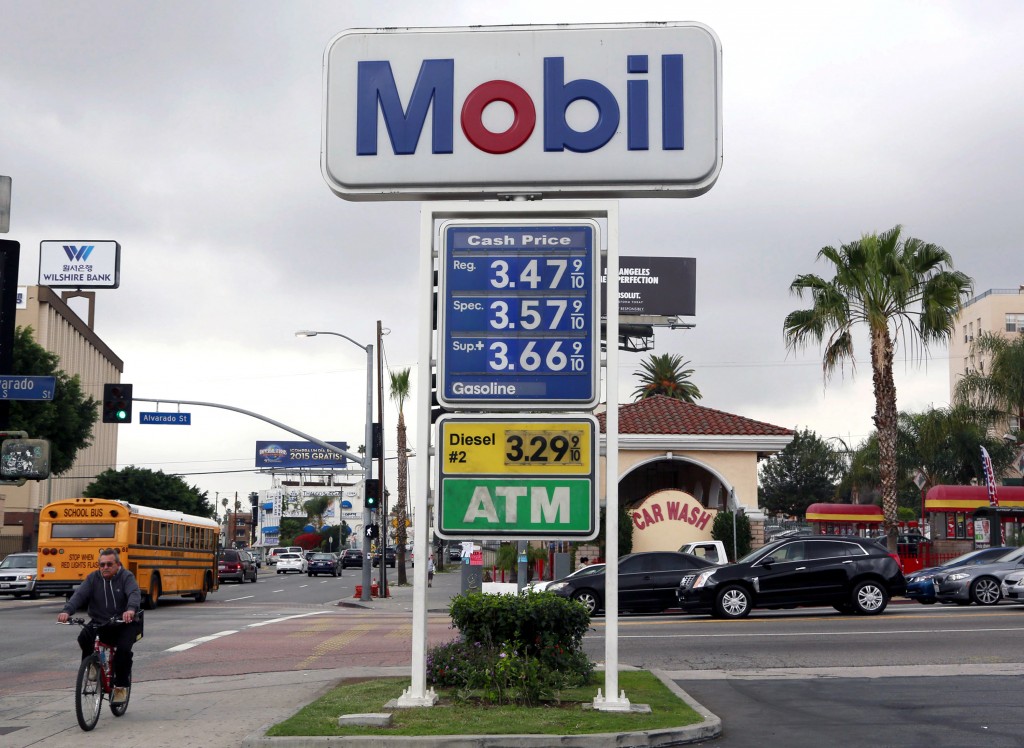- California Assembly OKs highest minimum wage in nation
- S. Korea unveils first graphic cigarette warnings
- US joins with South Korea, Japan in bid to deter North Korea
- LPGA golfer Chun In-gee finally back in action
- S. Korea won’t be top seed in final World Cup qualification round
- US men’s soccer misses 2nd straight Olympics
- US back on track in qualifying with 4-0 win over Guatemala
- High-intensity workout injuries spawn cottage industry
- CDC expands range of Zika mosquitoes into parts of Northeast
- Who knew? ‘The Walking Dead’ is helping families connect
Only in California: Gas prices soar as supply shrinks

A cyclist rides by a sign at a gas station in Los Angeles posting the latest gas prices on Friday, Feb. 27, 2015. Gas prices in California soared overnight as a result of a combination of supply-and-demand factors worsened by the shutdown of two refineries that produce a combined 16 percent of the states gasoline. (AP Photo/Nick Ut)
LONG BEACH, Calif. (AP) — Gas prices are soaring in California in a classic example of supply and demand after an explosion stopped gasoline production at an Exxon Mobil refinery while another remains offline due to labor unrest.
Average retail gas prices in the state have surged 25 cents a gallon in less than a week, from $2.98 per gallon for regular on Monday to $3.23 per gallon on Friday. That caps a run that saw the price of regular unleaded go up 60 cents per gallon since Jan. 30 as refineries prepare to shift to a summer blend of fuels.
In some areas of Southern California, gas station owners were forced to pass price hikes of 24 cents per gallon along to consumers on Thursday after seeing wholesale prices shoot up. Prices in Northern California lagged a day, but by Friday were also rising; an independent operator with a chain of gas stations around the San Francisco Bay area boosted prices 20 cents a gallon for regular on Friday, to $3.19.
The situation underscores the frustrating complexity of the gasoline market in California, where state environmental regulations mandate a specialized blend of fuel that isn’t used anywhere else in the U.S.
Because of that, California is economically isolated and can’t easily or quickly purchase fuel from outside the state in a crisis.
“Your market in California has about as much margin for error as Jennifer Lopez’s Academy Awards dress,” said Tom Kloza, global head of energy at the Oil Price Information Service.
“If you’re not a refiner who had a problem with a refinery this month — if you’re not Exxon Mobil — you have been rewarded with incredible profits this month. That’s just the way the market works.”
A unit of the Exxon Mobil refinery in Torrance that’s critical to producing California-grade gasoline exploded on Feb. 18, causing a fire and stopping new production there while the state investigates. The blast injured four contractors and rained a fine white ash on nearby homes and cars. State air quality regulators confirmed last week that the ash was not toxic.
At the time, another Tesoro oil refinery in Martinez, in Northern California, wasn’t producing oil due to labor unrest.
The two facilities combined make up 17 percent of the state’s crude oil processing capacity, said Gordon Schremp, a senior fuels specialist with the California Energy Commission.
Refineries in a few other places have the ability to produce gasoline that would meet California’s strict standards — including parts of Canada and Korea — but most refineries don’t want to because it’s expensive and prevents them from making other types of gasoline, he said. Also, the product would have to travel to the market, a process that could take weeks.
“It takes a while to get some significant supplies from outside,” Schremp said. “It’s very normal that we’d see a significant price spike.”
Gas station owners, meanwhile, chafed at having to pass the costs on to consumers. The profit margin for station owners was 18.5 cents per gallon in California on Friday, a break-even or money-losing proposition for many independent retailers, said Jeff Lenard, a spokesman for the National Association of Convenience Stores.
In Torrance, station owner Frank Scotto was forced to increase his prices by 24 cents per gallon on Thursday. He hasn’t seen such a spike since he went into the gas station business in 1967, he said.
“I printed out the price change and I’m framing this thing because I’ve never seen this kind of thing in all my years,” said Scotto, who owns a Mobil and Exxon station.
















Pingback: herve leger paris
unleaded
August 22, 2017 at 2:05 PM
Collaboration Forum